
Head and pronotum

Antenna
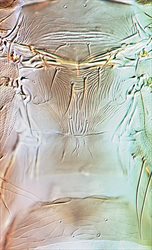
Meso & metanota, and tergite I
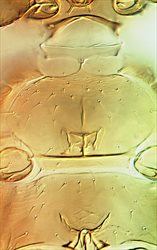
Meso & metasternal furcae
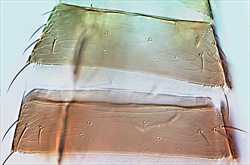
Tergites II-III
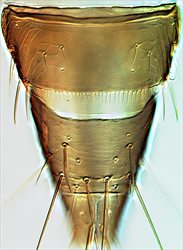
Tergites VIII-X

Male tergites VII-X
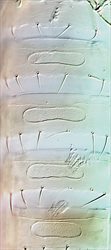
Male sternites II-VI
Female fully winged. Body light brown or almost bicoloured with head and thorax paler than brown abdomen; legs mainly yellow with femora weakly shaded, antennal segment III almost yellow; fore wings shaded with base paler. Antennae 7-segmented, III–IV with apex constricted, sense cone stout and forked. Head with 2 pairs of ocellar setae, pair III just outside anterior margins of ocellar triangle, pairs II and III subqual in length; postocular setae pair III as long as ocellar setae II; maxillary palps 3-segmented. Pronotum with 2 pairs of long posteroangular setae, 3 pairs of posteromarginal setae. Mesonotum with paired anterior campaniform sensilla, median pair of setae on posterior third of sclerite; mesothoracic furca with spinula but this is sometimes weak. Metanotal sculpture closely striate, median setae behind anterior margin; campaniform sensilla present; metasternal furca with no spinula. Fore wing first vein with 3 setae on distal half, second vein with about 14 setae. Abdominal tergites with no sculpture lines medially between campaniform sensilla, median setal pair small and far apart; tergite II with 4 lateral marginal setae; V–VIII with paired ctenidia laterally, on VIII posteromesad of spiracles; VIII with complete marginal comb; IX with 2 pairs of campaniform sensilla, X with short median split. Sternites without discal setae; setae S1 on VII arising in front of margin; pleurotergites without discal setae.
Male macropterous, body, legs and antennal segments I–III mainly yellow, tergites IV–VII increasingly brown medially, VIII–IX brown. Tergal posterior margins without lobes or teeth; VIII posteromarginal comb with few irregular teeth; IX with anterior campaniform sensilla present or absent. Sternites III–VII each with a wide pore plate.
The genus Stenchaetothrips currently includes 42 species, all associated with Poaceae and all originally from the Old World tropics, particularly Southeast Asia. The genus represents a radiation onto grasses derived from the genus Thrips. S. martini is one of only eight species in the genus with a well-developed spinula on the mesothoracic furca, and four of these eight are reported from species of bamboo (Mound et al., 2017).
Feeding on the leaves of its Poaceae host plants, and described from the fishpole bamboo, Phyllostachys aurea in New Zealand. In Britain it has been reported from an unidentified species of the similar bamboo genus Pleioblastus.
Recorded twice in Britain, on a bamboo Pleioblastus sp. growing under glass in West Sussex in 2002 (Collins, 2010a as S. spinalis), and on a specimen bamboo plant outdoors at the Royal Botanic Gardens, Kew, in 2010. Both populations were eradicated by the plant health authorities. This species was described from New Zealand, but has also been recorded from south-western France (Reynaud, 2010).
THRIPIDAE - THRIPINAE
Stenchaetothrips martini Mound, Gunawardana & Li
Stenchaetothrips martini Mound, Gunawardana & Li, 2017: 296
Collins DW (2010a) Thysanoptera of Great Britain: a revised and updated checklist. Zootaxa 2412: 21–41.
Mound LA, Gunawardana DN & Li DM (2017) A new species of Stenchaetothrips (Thysanoptera, Thripidae) from Bamboo, based on morphological and molecular data. Zootaxa 4323 (2): 295–300.
Reynaud P. (2010) Thrips (Thysanoptera). Chapter 13.1. BioRisk 4 (2): 767–791.